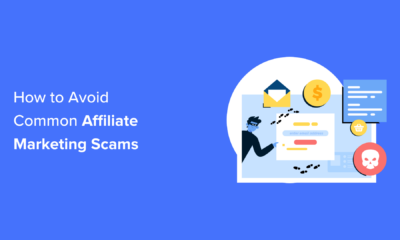AFFILIATE MARKETING
How to Make Money with Photography – Small Business Trends

If you buy something through our links, we may earn money from our affiliate partners. Learn more.
Photography can be so much more than a hobby. Those who enjoy photography often are inclined to turn their passions into successful small businesses. With some talent, a camera and a computer, any photo enthusiast has the potential to make money in the photography industry. There are so many ways to make money with photography, including the following 21 amazing methods.
21 Amazing Ways to Make Money with Photography
Do you dream of becoming a professional photographer? Do you have photography skills, a camera and a computer? Whether you want to specialize in wedding photography, sell poster prints online or edit photos for other photographers, you can make money in the photography industry.
Many photographers become successful small business owners by specializing in one or more photography niche, and sometimes diversifying their efforts is the formula for financial success. Interested in making money with photography? The next question then becomes where to sell photos, because there are many options. You can earn money as a photographer in the following 21 ways:
1. Create a Photography Blog
Photographers can make money by creating photography blogs featuring their work and expert advice. A photography blogger attracts visitors to their website by publishing vivid photographs, often for sale, and other web content including photography tutorials and articles about the craft. When a blog attracts a large enough following, it can be monetized by featuring ads, affiliate marketing links and other influencer marketing efforts.
2. Advertise Wedding Photography Services
You can establish a small business as a wedding photographer. There is always a great demand for shooting weddings, and a wedding photography business is a great way to make money in the industry. Remember, a wedding isn’t an opportunity simply to point and shoot your camera. The bride and groom want to look amazing in their wedding photos, so you’ll want to sharpen your photo editing skills. Taking impressive photos of weddings can then open doors to other event photography opportunities. Many wedding photographers start small and ultimately open their own studios.
3. Sell Stock Photos on Stock Photography Sites
One of the most popular ways to make money with photography is by selling your work on stock photography websites like Shutterstock and iStock. Stock sites allows customers to purchase permission to use a digital image for personal or commercial use. Photographers submit their best images to the stock sites, which then display the images for sale in their digital catalogs. Customers purchase the photography online, download the images, and the stock photography website pays the photographer a portion of the revenue.
4. Join Photo Contests
One way many budding photographers try making money with photography is by joining photo contests that award cash prizes for the best photos. You don’t have to look very hard to find a plethora of available photography contests, many offering substantial prize money. Not only does winning a photo contest mean you’re making money with photography, but it offers valuable exposure that can lead to other paid professional photography opportunities.
5. Sell Photo Prints
People are always looking for amazing photos and wall art to decorate their homes and workplaces. Some professional photographers make a living by selling photo prints on their own website. You might find a market selling landscape photography or travel photos, while others specialize in framed prints or canvas prints. Some photographers prefer to sell fine art prints, while others might sell more commercial images on their websites. When it comes to art, there’s a market for everything. If you’re just getting your start selling prints and don’t yet have your own website, a variety of online marketplaces like Fine Art America are available for selling high quality photos.
6. Run Photography Classes
Are you a skilled photographer with expertise to share? From finding the right cameras to the best studio lights, you can make money by running photography classes and inspiring aspiring photographers to follow in your footsteps. While you can teach photography to groups of local students, many photographers reach a larger audience by teaching photography online. Whether it’s through video tutorials on YouTube or Instagram or a webinar posted to your own website, you can attract an online audience by creating engaging educational content about photography. Then, you can charge people to access the content or you can monetize the website where the content resides.
7. Make Money with Travel Photography
Do you love traveling? You can make money photographing your experiences. There is always a demand from publishers and advertisers for travel-related photos, especially photos of popular tourist destinations. Freelance travel photographers who can also write well can boost their incomes by writing accompanying written content for travel magazines and travel agencies.
8. Specialize in Portrait Photography
Portraits continue to be in high demand among all demographics as people are always looking for a quality photographs of families, couples, teams and individuals. A photographer who specializes in shooting portraits can open their own studio or travel to take photos at locations like schools and shopping centers. While anyone can take their own portrait, not everyone is a skilled photographer who has honed the craft of portrait making and photo editing.
9. Sell Eye-catching Posters and Merch
Some online photography marketplaces specialize in posters, and photographers can transform their images into eye-catching wall art to sell to the public. Customers seeking engaging poster-sized images can visit sites like Redbubble to purchase prints, and the photographer earns a portion of the sales. Photographers also can make money by selling their photos to print on phone cases, stationery, clothing, blankets and more.
10. Offer Prints on Demand
Photographers with ample portfolios can set up their own online stores and sell prints on demand. Availabile photographs can be showcased in an online gallery, and a customer can order prints of photos they want to own, which can be sold in a variety of sizes and on multiple mediums. There’s no need to print photos in advance and risk the investment in unsold prints, just display your portfolio and wait for customers to order their favorites.
11. Freelance for a Magazine
Print and online publications like magazines and newspapers are always in need of high-quality photos, and you can make money from photography by selling images to them. Some freelance photographers take assignments from specific publications, while others take photos they believe will be of interest and sell them to the highest bidder. Publication niches that feature freelance photography range from travel, outdoors and entertainment to auto sales and real estate listings.
12. Become a Paparazzo
If you live in an area known for its celebrity sightings, you might be able to make money as a paparazzo photographer, shooting images of major names at events and in their everyday lives. Paparazzi jobs in places like Los Angeles and New York City are lucrative, and the photographers are well paid for in-demand shots of celebrities, but it is also a challenging and highly-competative market.
13. Advertise Maternity Photo Shoots
Some professional photographers make names for themselves by specializing in the maternity photo shoot niche. Expectant mothers and their families love to cherish the memories of a pregnancy, and a photographer who can capture that special glow can build a successful small business with loyal clientele. Photographers can either open their own studio where they conduct maternity photo shoots, or they can take their photos on location in cooperation with their customers.
14. Promote Pet Photography
Do you relate well to animals? Pet photography is a niche growing in popularity as more customers look to preserve precious memories of their furry family members. Photographers who can establish rapport with pets, and who have the reflexes to capture fleeting photographic moments before they pass, can find success promoting pet photography, which can take place at a studio but more often takes place at locations like parks and clients’ homes.
15. Sell Real Estate Photos for Advertisements
Taking photos for real estate advertisements can be a lucrative gig for professional photographers. When listing properties on websites and in trade publications, realtors need high-quality photographs to showcase the homes. The better the photographs, the more interest they will generate. You can make money with photography by sharpening your photographic skills, shooting buildings in ways that bring them to life and showcase their best features.
16. Photograph Small Businesses
Its hard for any modern small business to succeed without a web presence, and nobody wants to visit a website without images. While some companies will choose to purchase stock photographs for their websites, many small businesses seek professional photographers to capture these important images. You can make money from photography by specializing in providing services to small businesses, shooting photos of their properties, teams, products and services.
17. Become an Instagram Influencer
If you frequently post high-quality, engaging photographs to social media platforms like Instagram, and you develop a large following of fans, you can monetize your social media presence as an Instagram influencer. Influencers produce an abundance of social media content, then earn money through activities like selling merchandise, featuring affiliate links and accepting donations.
18. Photograph Events
Weddings aren’t the only events where photographers are in high demand. From company events to homecoming dances to family reunions, people love having photos to remember life’s special moments. Sometimes event photographers are hired to take a portfolio of images for the organization, while others take individual shots and sell photos to attendees. By offering their business cards at events, photographers can take advantage of key networking opportunities and further expand their small businesses.
19. Edit and Retouch Photos
You don’t have to be behind the camera to make money with photography. If you are a photographer who has mastered the craft of editing and retouching photos, you can form a small business performing the service for others. You don’t even need a fancy camera to retouch photos. All you need is a computer and any of an assortment of available photo editing software options.
20. Serve as Photography Assistant
A photographer just starting their career might make money serving as a photography assistant to another professional. An assistant photographer can learn valuable skills at the side of a seasoned photographer while making money helping with the photography equipment list, providing customer service, managing schedules, and other tasks related to the overall photography business.
21. Specialize in Infant Photography
Do you have a knack with kids? If you can connect with babies from behind the lens, you can earn a decent amount of money working as an infant photographer. Practically every new parent wants to capture the precious few moments when their children are in the infant stage, but special skill is required to take quality photos of babies. A photographer who sharpens those skills and specializes in infant photography can benefit from a high-demand niche that requires a professional with the right demeanor to work with kids.
How much money do photographers make?
How much money do photographers make? A photographer’s income can vary widely depending on the professional’s niche, location and volume of work. According to the U.S. Federal Bureau of Labor Statistics, the average wage for photographers is between $30,000 and $40,000 per year, although the top 10% of earners make more than $70,000 each year. Nationwide, the median hourly wage for a photographer is just under $20 an hour, with half of photographers earning more than that wage and the other half making less.
Which type of photography makes the most money?
Photography wages widely vary because there is such a variety of niches in multiple markets, each with varying levels of demand and profitability. A high-fashion commercial photographer, for example, will make far more money than a family portrait studio in a small town. In general, commercial and marketing photographers, including advertising photography and real estate photography, earn more than those who sell photos to individuals, simply because there is a high demand and more money to be spent by big business than by private families.
Image: Depositphotos
AFFILIATE MARKETING
Franchising Is Not For Everyone. Explore These Lucrative Alternatives to Expand Your Business.

Opinions expressed by Entrepreneur contributors are their own.
Not every business can be franchised, nor should it. As the founder and operator of an exciting, new concept, it’s hard not to envision opening a unit on every corner and becoming the next franchise millionaire. It’s a common dream. At one time, numerous concepts were claiming to be the next “McDonald’s” of their industry.
And while franchising can be the right growth vehicle for someone with an established brand and proven concept that’s ripe for growth, there are other options available for business owners who want to expand their concept into prime locations before their competition does but who don’t want to go it alone for a number of reasons. For instance, they may not have the resources or cash reserves to finance a franchise program (it is important to note that while franchising a business does leverage the time and capital of others to open additional units, establishing a franchise system is certainly not a no-cost endeavor). Or they don’t want the responsibilities and relationship of being a franchisor and would rather concentrate on running their core business, not a franchise system.
Related: The Pros and Cons of Franchising Your Business
But when you have eager customers asking to open a branded location just like yours in their neighborhood, it’s hard to resist. You might think: What if I don’t jump on the deal, and I miss out on an opportunity that might not come around again?
Licensing your intellectual property, such as your name, trademarks and trade dress, in exchange for a set fee or percentage of sales is one way to accomplish this without having to go the somewhat more laborious and legally controlled franchise route. Types of licensing agreements range from granting a license to allow another entity to manufacture or make your products to allowing someone to use your logo and name for their own business. Unlike in a franchise, your partner in a licensing situation will only be allowed certain predetermined rights to sell your products and services, not an all-in agreement to give them a turnkey business, accompanied by training and support, in exchange for set fees. A licensing agreement spells out each party’s rights, responsibilities, and what they can and cannot do under the terms of the agreement. Having a lawyer draw up the paperwork is vital, as well as consulting with a trusted business advisor who has helped others along this path and can shorten your learning curve while protecting your rights. License agreements are governed by contract law as opposed to franchise laws. However, care must be taken: To ensure that you’re staying in your lane and not crossing over into franchisor territory, you’ll want your advisers to detail what you can and can’t do as a licensor.
For instance, a license agreement excludes you from being involved in the day-to-day operations of the licensee’s business. While having no oversight may sound like a relief, it can be a double-edged sword, especially for people who are used to controlling all aspects of their products or services. You won’t have to provide licensees with ongoing services, such as marketing materials and continuous training, but it also means you have no control over how they run their business, their product mix or even how they decorate their space. If you’re a type-A, this may be hard for you.
Most people are more familiar with trademark licensing with a third party because these agreements are big in the sports and entertainment industries, where a celebrity lends their name to endorse a product, whether it’s branded athletic wear or trendy foodservice menu items such as pizza, chicken, or even gelato.
Using a celebrity’s cache garners media attention you might otherwise never get. But not everyone who comes up with a great concept or product has the recognition that would allow them to attract famous business partners or endorsements, and rabid fans that follow.
There are other methods of getting your products in front of more consumers. Some coffee concepts, including Caribou for example, have created market saturation by both franchising traditional stores and granting licenses for nontraditional locations, such as airports, big-box stores, and college campuses. Others, on the other hand, like Starbucks, employ a combination of company-owned stores and licensees in high-traffic locations where a small kiosk can service a high-density population of shoppers. And, of course, bags and pods of these brands’ coffee blends are also sold in retail locations such as grocery stores.
Related: Startups Must Protect Their Trademark. Here’s How and Why
But again, here’s that cautionary note: If you go the licensing route for your products or services, be careful not to cross over into trying to direct the way that licensees do their business, from selecting locations to training employees.
While licensing or franchising may be valid business growth vehicles for many brands, additional business structures that can be considered include:
- Company-owned stores: Opening corporate locations using bank loans and/or the profits from already opened units.
- Dealerships or distributorships: In a distributor relationship, products are purchased from a manufacturer and then sold through local dealers.
- Agency relationships: These are similar to the relationships you’d have with dealers, but in this case, an agent or representative of your company sells your services to a third party. The important distinction to remember so that the relationship doesn’t cross over into franchise territory is that you, as the provider of the services, pay the agent (as an independent sales rep) rather than the agent collecting the money and paying you.
- Joint ventures: In this case, you, as the concept owner, would take on an operating partner who also invests his own funds in the business. The two of you would then share in the equity and profits at the percentage rate of your investment.
The appropriate method to grow your business depends on several factors, including your type of concept, service, or products; your risk aversion factor; your access to capital; where you’re located; and current market conditions. So, if you choose another option to franchising, be cognizant of not slipping into becoming a franchise. The Federal Trade Commission’s regulations define a franchise as meeting at least three standards: a shared name, fees and royalty payments paid to the company by the franchisee, and ongoing support and control of the day-to-day operations by the franchisor.
Keep in mind that if you start with one expansion method, you can consider changing that structure with legal and professional guidance should your business needs merit a shift in strategy. Case in point: some licensors will eventually convert licensees to franchises under a newly crafted agreement and program if they see the need to change the fee structure and maintain additional control over operations.
Slow growth can be detrimental to a business, but not picking the right vehicle for that growth can be worse than standing still. That’s why doing your homework — consulting with professionals, such as attorneys, accounting and franchising advisors, and talking to others in the same boat as you will save you from drifting too far from shore.
AFFILIATE MARKETING
How to Control the Way People Think About You
Opinions expressed by Entrepreneur contributors are their own.
In today’s digital age, where personal branding and public perception play a vital role in success, strategic PR efforts have become more important than ever. Ulyses Osuna, the founder of Influencer Press, joined our show to share valuable insights on the significance of PR, the evolving landscape, and the keys to achieving business growth while maintaining a fulfilling personal life.
One of the key takeaways from the conversation was the importance of strategic PR efforts in building a personal brand and shaping public perception. Ulyses emphasized that PR is not just about getting media coverage; it’s about controlling the narrative and shaping how others perceive you. By strategically positioning yourself and your brand through effective PR, you can influence public opinion and establish yourself as an authority in your field. Another crucial aspect discussed was the power of leveraging relationships and connections.
Ulyses highlighted the “Buglight Concept,” which involves utilizing the support and connections of others to achieve success. By building strong relationships and leveraging the networks of influential individuals, you can significantly expand your reach and influence. Ulyses’s own success with Influencer Press is a testament to the power of connections in the PR world. While professional success is undoubtedly important, Ulyses also stressed the significance of balancing personal time and fulfillment. In the pursuit of business growth, it’s easy to neglect personal well-being and relationships. However, Ulyses emphasized that true success lies in finding a balance between professional achievements and personal happiness.
By prioritizing personal time and fulfillment, entrepreneurs can sustain long-term growth and avoid burnout. In the ever-evolving landscape of PR, Ulyses highlighted the need for a clear mission when seeking press coverage. He emphasized the importance of aligning your brand with a cause or purpose that resonates with your target audience. By having a clear mission and purpose, you can attract media attention that aligns with your values and goals, ultimately enhancing your brand’s reputation and reach. Additionally, Ulyses discussed the importance of pricing services correctly and finding the right balance between personal involvement and business scalability.
The conversation also touched upon the dynamics of client relationships and the impact of showcasing external support. Ulyses emphasized the value of building strong relationships with clients and going above and beyond to exceed their expectations. Furthermore, he highlighted the importance of showcasing external support, such as media coverage or endorsements, to establish credibility and attract new clients. Ulyses’s own podcast, The Blacklist, where he shares insights and interviews successful entrepreneurs, was also discussed. He explained that launching the podcast was a way to give back to the entrepreneurial community and share valuable knowledge.
By continuously learning from others and implementing breakthrough ideas, Ulyses emphasized the importance of immediate action and continuous improvement for business growth. In conclusion, strategic PR efforts are essential for building a strong personal brand and controlling the narrative in today’s digital age. By leveraging relationships, finding a balance between personal and professional life, and having a clear mission, entrepreneurs can shape public perception, expand their reach, and achieve long-term success. Ulyses Osuna’s insights serve as a valuable guide for those looking to navigate the ever-changing landscape of PR and personal branding.
About The Jeff Fenster Show
Serial entrepreneur Jeff Fenster embarks on an extraordinary journey every week, delving into the stories of exceptional individuals who have defied the norms and blazed their own trails to achieve extraordinary success.
Subscribe to The Jeff Fenster Show: Entrepreneur | Apple | Spotify | Google | Pandora
AFFILIATE MARKETING
Set Your Team up for Success and Let Them Browse the Internet Faster

Disclosure: Our goal is to feature products and services that we think you’ll find interesting and useful. If you purchase them, Entrepreneur may get a small share of the revenue from the sale from our commerce partners.
According to TeamStage, 31 percent of employees waste about a half hour each day, and the top 10 percent of them can waste as much as three hours in a day. Part of that might be attitude, but the other part might be hangups caused by internet speed and advertisements. To nip that lost time in the bud, consider equipping yourself or your team with a tool to help stay on task.
From April 15 through 21, this five-year subscription to Control D Some Control Plan is on sale for just $34.97 (reg. $120). This is the best price for this deal online. This tool is designed to help users browse and use the internet faster while also blocking ads.
Control D is described as a “one-touch solution” for taking control over the productivity of your computer and internet usage. The deal supports use for up to ten devices, and it empowers each user to block advertisements, enjoy faster browsing, and set internet safety rules and restrictions for kids.
Control D’s bandwidth is substantial. It can accommodate up to 10,000 custom rules, block more than 300 servers, support multiple profiles, and unlimited usage. This robust and well-designed tool is a reliable option for any business leader who wants to liberate themselves or team members from distractions online.
Control D is rated a perfect 5/5 stars on Product Hunt.
Remember that from April 15 through 21, this 5-year subscription to Control D Some Control Plan is on sale for just $34.97 (reg. $120)—the best price on the web.
StackSocial prices subject to change.
-

 PPC6 days ago
PPC6 days ago19 Best SEO Tools in 2024 (For Every Use Case)
-
SEARCHENGINES6 days ago
Daily Search Forum Recap: April 19, 2024
-
SEARCHENGINES7 days ago
Daily Search Forum Recap: April 18, 2024
-

 WORDPRESS6 days ago
WORDPRESS6 days agoHow to Make $5000 of Passive Income Every Month in WordPress
-

 SEO6 days ago
SEO6 days ago25 WordPress Alternatives Best For SEO
-

 WORDPRESS5 days ago
WORDPRESS5 days ago13 Best HubSpot Alternatives for 2024 (Free + Paid)
-

 WORDPRESS6 days ago
WORDPRESS6 days ago7 Best WooCommerce Points and Rewards Plugins (Free & Paid)
-

 MARKETING6 days ago
MARKETING6 days agoBattling for Attention in the 2024 Election Year Media Frenzy
















You must be logged in to post a comment Login